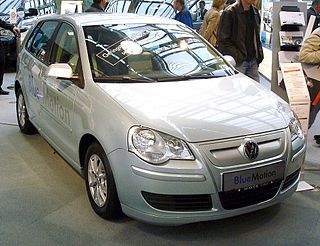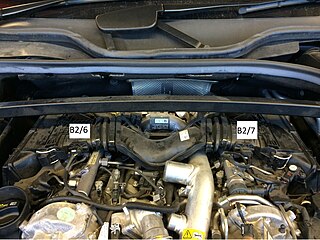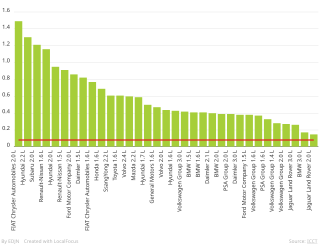Related Research Articles

Volkswagen is a German automobile manufacturer headquartered in Wolfsburg, Lower Saxony, Germany. Founded in 1937 by the German Labour Front under the Nazi Party and revived into the global brand it is known as today post World War II by the British Army officer Ivan Hirst, it is known for the iconic Beetle and serves as the flagship brand of the Volkswagen Group, the largest automotive manufacturer by worldwide sales in 2016 and 2017. The group's biggest market is in China, which delivers 40 percent of its sales and profits. Its name is derived from the German-language terms Volk and Wagen, translating to "people's car" when combined.

The Volkswagen Golf is a compact car/small family car (C-segment) produced by the German automotive manufacturer Volkswagen since 1974, marketed worldwide across eight generations, in various body configurations and under various nameplates – including as the Volkswagen Rabbit in the United States and Canada, and as the Volkswagen Caribe in Mexico (Mk1).

A catalytic converter is an exhaust emission control device which converts toxic gases and pollutants in exhaust gas from an internal combustion engine into less-toxic pollutants by catalyzing a redox reaction. Catalytic converters are usually used with internal combustion engines fueled by gasoline or diesel, including lean-burn engines, and sometimes on kerosene heaters and stoves.

The Volkswagen Jetta is a compact car/small family car manufactured and marketed by Volkswagen since 1979. Positioned to fill a sedan niche above the firm's Golf hatchback, it has been marketed over seven generations, variously as the Atlantic, Vento, Bora, City Jetta, Jetta City, GLI, Jetta, Clasico, and Sagitar.

The Volkswagen Touareg is a car produced by German automaker Volkswagen Group since 2002 at the Volkswagen Bratislava Plant. Considered to be the first luxury mid-size SUV from Volkswagen, the vehicle was named after the nomadic Tuareg people, inhabitants of the Saharan interior in North Africa. Originally, the Touareg was developed together with the Porsche Cayenne and the Audi Q7, and as of October 2020, the Touareg was developed together with the Audi Q8, the Bentley Bentayga and the Lamborghini Urus. This family of vehicles are all unibody SUVs with independent suspension. The first generation (2002–2010) offered five, six, eight, ten and twelve-cylinder engine choices.
Selective catalytic reduction (SCR) means of converting nitrogen oxides, also referred to as NO
x with the aid of a catalyst into diatomic nitrogen, and water. A reductant, typically anhydrous ammonia, aqueous ammonia, or a urea solution, is added to a stream of flue or exhaust gas and is reacted onto a catalyst. As the reaction drives toward completion, nitrogen, and carbon dioxide, in the case of urea use, are produced.

Diesel exhaust fluid is a liquid used to reduce the amount of air pollution created by a diesel engine. Specifically, DEF is an aqueous urea solution made with 32.5% urea and 67.5% deionized water. DEF is consumed in a selective catalytic reduction (SCR) that lowers the concentration of nitrogen oxides in the diesel exhaust emissions from a diesel engine.
A NOx adsorber or NOx trap (also called Lean NOx trap, abbr. LNT) is a device that is used to reduce oxides of nitrogen (NO and NO2) emissions from a lean burn internal combustion engine by means of adsorption.

The Volkswagen Crafter, introduced in 2006, is the largest three- to five-ton van produced and sold by the German automaker Volkswagen Commercial Vehicles. The Crafter officially replaced the Volkswagen Transporter LT that was launched in 1975, although it is known as the LT3, its production plant code.

The Volkswagen Golf Mk3 is a medium-sized compact family car. It's the third generation of the Volkswagen Golf and the successor to the Volkswagen Golf Mk2, which was produced by Volkswagen from August 1991 to 2002.

BlueMotion is a trading name for certain car models from the Volkswagen Group, emphasizing higher fuel efficiency.

The Mercedes-Benz OM642 engine is a 3.0 litres (2,987 cc), 24-valve, aluminium/aluminium block and heads diesel 72° V6 engine manufactured by the Mercedes-Benz division of Daimler AG as a replacement for the Mercedes straight-5 and straight-6 cylinder engines.

The Volkswagen Passat is a front-engine D-segment large family car manufactured and marketed by Volkswagen from 2005 to 2011 (B6) and from 2010 to 2015. Respectively the six and seventh generation Passat, and internally designated B6 and B7, they were marketed in sedan and wagon bodystyles in front-wheel as well as all-wheel drive configurations, with a range of petrol and diesel engines.

TDI is Volkswagen Group's term for its current common rail direct injection turbodiesel engine range that have an intercooler in addition to the turbo compressor.

The Volkswagen emissions scandal, sometimes known as Dieselgate or Emissionsgate, began in September 2015, when the United States Environmental Protection Agency (EPA) issued a notice of violation of the Clean Air Act to German automaker Volkswagen Group. The agency had found that Volkswagen had intentionally programmed turbocharged direct injection (TDI) diesel engines to activate their emissions controls only during laboratory emissions testing, which caused the vehicles' NOx output to meet US standards during regulatory testing. However, the vehicles emitted up to 40 times more NOx in real-world driving. Volkswagen deployed this software in about 11 million cars worldwide, including 500,000 in the United States, in model years 2009 through 2015.

A defeat device is any motor vehicle hardware, software, or design that interferes with or disables emissions controls under real-world driving conditions, even if the vehicle passes formal emissions testing. The term appears in the US Clean Air Act and European Union regulations, to describe anything that prevents an emissions control system from working, and applies as well to power plants or other air pollution sources, as to automobiles.

From 2014 onwards, software which manipulated air pollution tests was discovered in vehicles from some car makers; the software recognized when the standardized emissions test was being done, and adjusted the engine to emit less during the test. The cars emitted much higher levels of pollution under real-world driving conditions. Some cars' emissions were higher even though there was no manipulated software.

The Volkswagen Jetta is a compact car, the fifth generation of the Volkswagen Jetta and the successor to the Volkswagen Bora which was manufactured by Volkswagen between 2005 and 2010, and up to 2012 in China. It is a three-box sedan derivative of the Golf Mk5. It was marketed as the Volkswagen Bora in Mexico and Colombia, Volkswagen Vento in Argentina, Chile and Uruguay, and Volkswagen Sagitar in China.
References
- ↑ "Ward's Announces 10 Best Engines Winners for 2007". Ward's AutoWorld. WardsAuto.com. 2006-12-05. Archived from the original on 2009-07-22. Retrieved 2009-07-25.
- ↑ "Ward's 10 Best Engines Winners Reflect Fuel-Economy Focus (2008)". Ward's AutoWorld. WardsAuto.com. 2007-12-13. Archived from the original on 2008-08-21. Retrieved 2017-03-06.
- ↑ Harris, Andrew M (18 February 2016). "Mercedes Faces Lawsuit Over BlueTec Clean Diesel Emissions". Bloomberg News . Retrieved 8 December 2016.
- ↑ Teichert, Erica (6 December 2016). "U.S. judge throws out emissions fraud lawsuit against Mercedes". Reuters . Retrieved 8 December 2016.
- ↑ "Home | MB BlueTEC Settlement". www.mbbluetecsettlement.com. Retrieved 28 September 2022.
- ↑ "Home | Kalra v. Mercedes-Benz Canada, Inc". www.bluetecsettlement.ca. Retrieved 28 September 2022.
- ↑ "2008 VW Jetta TDi coming with BlueTec and 50 state emissions".
- ↑ "The future demands more environmentally friendly technologies". Archived from the original on 2015-10-06.
- ↑ "Daimler verliert Patentstreit um Abgastechnik". Faz.net.
- ↑ "Ingenieure gestehen Installation von Manipulations-Software". bild.de.
- ↑ Ewing, Jack (2015-10-04). "Volkswagen Engine-Rigging Scheme Said to Have Begun in 2008". The New York Times.
- ↑ William Boston (5 October 2015). "Volkswagen Emissions Investigation Zeroes In on Two Engineers". WSJ.
- ↑ "Mercedes to bring Bluetec diesel to European-market Sprinters by 2012, but we get it first!". Apr 20, 2010.
- ↑ "Light-Duty Vehicles, Light-Duty Trucks, and Medium-Duty Passenger Vehicles:Tier 2 Exhaust Emission Standards and Implementation Schedule" (PDF). EPA-420-B-16-015. Environmental Protection Agency. March 2016.[ permanent dead link ]
- ↑ http://publications.tno.nl/publication/34616868/a1Ug1a/TNO-2015-R10702.pdf [ bare URL PDF ]
- ↑ Traufetter, Gerald (2 February 2016). "Mercedes-Benz: C-Klasse unter Manipulationsverdacht". Der Spiegel.
- ↑ "Mercedes-Benz Faces Federal Investigation over Alleged Diesel Emissions Cheats". 2016-04-22.
- ↑ "Daimler may have used software to cheat on US emissions tests".
- ↑ "Software may have helped Daimler pass U.S. Emissions tests: Report". Reuters. 2018-02-18.
- ↑ "Abgasskandal: US-Ermittler belasten Daimler schwer". Spiegel Online. 2018-02-18.